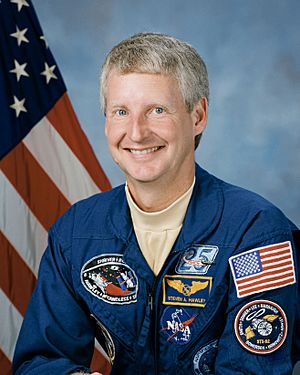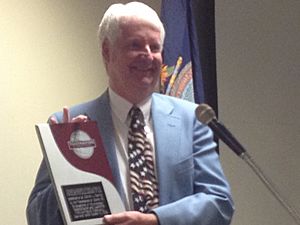Steven Hawley facts for kids
Quick facts for kids
Steven Hawley
|
|
|---|---|
 |
|
| Born |
Steven Alan Hawley
December 12, 1951 Ottawa, Kansas, U.S.
|
| Space career | |
| NASA astronaut | |
|
Time in space
|
32d 2h 42min |
| Selection | NASA Group 8 (1978) |
| Missions | |
|
Mission insignia
|
|
Steven Alan Hawley, born on December 12, 1951, is a retired NASA astronaut and astronomer. He flew on five different Space Shuttle missions for the United States. Today, he is a special professor of physics and astronomy at the University of Kansas.
Contents
Steven Hawley's Early Life and Education
Steven Hawley was born in Ottawa, Kansas, on December 12, 1951. His parents were Dr. and Mrs. Bernard Hawley. One of his brothers, John F. Hawley, was a scientist who studied the universe. John even won a big award called the Shaw Prize in Astronomy in 2013.
Steven Hawley finished high school in Salina, Kansas, in 1969. He considers Salina his hometown. He then went to the University of Kansas. In 1973, he earned two degrees with top honors in Physics and Astronomy. During his summers, he worked as a research assistant. He spent time at the U.S. United States Naval Observatory in Washington, D.C. He also worked at the National Radio Astronomy Observatory in West Virginia.
Hawley continued his studies at the University of California, Santa Cruz. He earned his doctorate degree in Astronomy and Astrophysics in 1977.
Steven Hawley's Career as an Astronomer
Before joining NASA in 1978, Steven Hawley worked as a researcher. He was at the Cerro Tololo Inter-American Observatory in Chile. His work involved studying glowing clouds in space called nebulae. He also looked at galaxies that show special light. He focused on finding out what chemicals these space objects were made of. His research was published in important astronomy magazines.
After his time as an astronaut, Hawley became a professor. He taught physics and astronomy at the University of Kansas. He also led the engineering physics program there.
Steven Hawley's Space Flights
Steven Hawley spent a total of 32 days, 2 hours, and 41 minutes in space. He flew on five different Space Shuttle missions. He was a mission specialist on these flights. His missions included STS-41D in 1984, STS-61C in 1986, STS-31 in 1990, STS-82 in 1997, and STS-93 in 1999.
Hawley was the last astronaut from his group (NASA Astronaut Group 8) to fly into space. He is also the only astronaut who helped launch the Hubble Space Telescope (on STS-31). Later, he flew on a mission to fix and upgrade it (on STS-82).
STS-41-D: First Flight on Discovery
The mission STS-41-D was the first flight of the Space Shuttle Discovery. It launched on August 30, 1984, from Kennedy Space Center, Florida. The mission lasted seven days. The crew successfully launched three satellites. They also did experiments, including one with a giant IMAX camera. The mission orbited the Earth 96 times.
Before this successful launch, there was a try that didn't work. Two of the shuttle's main engines started, but the third one didn't. Hawley reportedly made a joke to ease the tension. He said, "Gee, I thought we'd be a lot higher at MECO!" (MECO means Main Engine Cutoff).
STS-61-C: A Winter Launch on Columbia
STS-61-C was launched on January 12, 1986, aboard the Space Shuttle Columbia. This mission also took off from Kennedy Space Center. It landed at Edwards Air Force Base in California at night. During the six-day flight, the crew launched a satellite. They also did experiments related to space science and how materials behave in space.
STS-31: Launching the Hubble Space Telescope
STS-31 launched on April 24, 1990, using the Space Shuttle Discovery. This five-day mission was very important. The crew successfully launched the Hubble Space Telescope into orbit. This powerful telescope helps scientists learn about the universe. The astronauts also did other experiments. They studied how crystals grow and how weightlessness affects things. They flew at a record-setting height of 380 miles above Earth.
STS-82: Fixing the Hubble Space Telescope
STS-82 was the second mission to fix the Hubble Space Telescope. It launched at night on February 11, 1997, aboard Discovery. Steven Hawley's main job was to use the shuttle's 50-foot robot arm. He used it to grab the Hubble Telescope. After astronauts made repairs and upgrades during spacewalks, he put the telescope back into space. The mission lasted almost 10 days. The Hubble Telescope was also moved to a higher orbit.
STS-93: Deploying the Chandra X-ray Observatory
STS-93 launched at night on July 22, 1999, using the Space Shuttle Columbia. Steven Hawley was the flight engineer for this five-day mission. The main goal was to launch the Chandra X-ray Observatory. This is another powerful telescope that studies X-rays from space. It is one of NASA's "Great Observatories." Hawley also operated a second telescope on board. This telescope observed objects in our Solar System using ultraviolet light.
Steven Hawley's Organizations and Personal Life
Steven Hawley is a member of several important science groups. These include the American Astronomical Society and the American Institute of Aeronautics and Astronautics. He is now retired and lives in Lawrence, Kansas.
Hawley married fellow astronaut Sally Ride in 1982. They divorced in 1987. Later, he married Eileen M. Keegan. She used to work for NASA. She also served as a spokeswoman for the Kansas Governor in 2013.
Steven Hawley enjoys many hobbies. He likes basketball, softball, golf, and running. He also enjoys playing bridge and umpiring sports games. He even appeared on an episode of the TV show Home Improvement.
Honors and Awards for Steven Hawley
Steven Hawley has received many awards and honors throughout his career. Here are some of them:
- Evans Foundation Scholarship, 1970
- University of Kansas Honor Scholarship, 1970
- Summerfield Scholarship, 1970–1973
- Veta B. Lear Award, 1970
- Stranathan Award, 1972
- Outstanding Physics Major Award, 1973
- University of California Regents Fellowship, 1974
- NASA Space Flight Medal (received five times for his missions)
- NASA Exceptional Service Medal (1988, 1991)
- Presidential Rank Award (1994, 1999)
- Kansas Aviation Hall of Fame, 1997
- University of Kansas Distinguished Service Citation, 1998
- NASA Distinguished Service Medal (1998, 2000)
- Inducted into the Astronaut Hall of Fame (2007)
- Distinguished Alumni Award from the University of Kansas (2007)
- Distinguished Alumni Award from UC Santa Cruz, 1991
- Communication and Leadership Award (2015)


